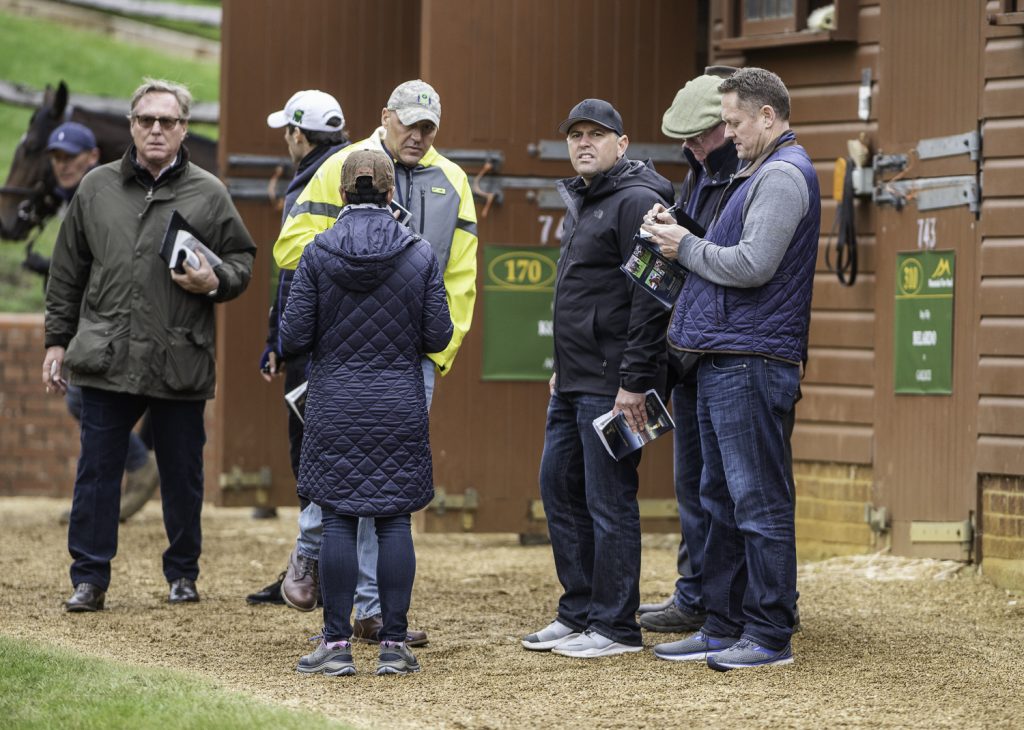
Chad Brown and Team at Tattersalls October 2019
By: Steve Zorn
Many of my columns at pastthewire.com this year have pointed out how hard it is for a thoroughbred owner to make money. Yearlings and two-year-olds, especially those with good pedigrees or fast breezes, sell for much more than it’s likely they will earn on the race track; training and vet expenses keep going up; and purses, even when supplemented by casino revenues, haven’t even kept up with inflation. For some owners, that doesn’t matter.
They have more money than they know what to do with (well, I suppose they could pay a lot more in taxes, but that’s for another column); what they want is a good horse, a Kentucky Derby or Breeders Cup runner.
Lots of owners, though, just love horses and racing and are willing to lose a bit of money to be involved in the game. And some owners actually hope, against all the evidence, to make a profit. But for both these groups, the idea of losing millions a year for decades has limited appeal. They might not need racing to pay their mortgages, but they’d prefer not to lose too much. Is there anything a current or aspiring owner like that can do to improve their odds of success?
Most buyers who are looking for a stakes-level horse buy at the major yearling and two-year-old sales, and most use a bloodstock agent either to buy for them or to advise on their purchases. Sometimes an agent will work for a single client, like Demi O’Byrne for Coolmore or John Ferguson for Sheikh Mohammed’s Godolphin empire. More often, a bloodstock agent will work for a variety of clients, somehow balancing their interests as the agent evaluates thoroughbred prospects. Some agents are good people who’ve spent their lives in the racing world and who have an eye for a promising horse. Others are more skilled at verbally romancing clients than at picking out good horses. And sometimes they’re just thieves, agents who take kickbacks from consignors in exchange for bidding on a horse, or who collude with the seller to bid up the price of a horse far beyond its actual value. To protect pastthewire.com from lawsuits, I won’t name these bad actors here, but we know who you are.
So, lesson 1 for the aspiring buyer: avoid the bad agents. But even if you can find a good, honest agent, can you have a decent chance of at least breaking even? Perhaps surprisingly, the answer is yes.
For nearly 20 years, I’ve been friends with, and occasionally worked with, Jeff Seder and Patti Miller, who operate as EQB, Inc., evaluating and buying young horses at all the major US thoroughbred auctions. I’ve owned a few horses in partnership with them, and my NY-bred stakes winner Introspect spent a winter vacation at their Pennsylvania farm. Jeff has spent many years developing sophisticated evaluation tools, including a heart-scan database for comparing prospects to known winners, and slow-motion video for seeing how those two-year-olds breeze. By marrying those tools with Patti’s eye for a good horse and her expertise in administering heart scans, EQB has managed the unthinkable: horses they’ve bought for their clients, in the aggregate, actually make money.
At my request, Jeff put together two spreadsheets. One shows the results for every horse EQB bought in 2016 – horses that are now five and six years old, so we can have a reasonable idea of how they turned out. The other shows all their results for the horses they bought for Ahmed Zayat in the years before American Pharoah’s Triple Crown. These data show that, when you include both racetrack earnings and the amounts that owners received when selling the horses as broodmare or stallion prospects, it’s possible to come out ahead.
In 2016, EQB bought 65 horses, at prices ranging from $10,000 to $675,000, for a total of $9,478,500, an average of just under $146,000, with none of those million-dollar disappointments that prominent owners often purchase. Six of those 65 horses never raced. The remaining 59 have, so far, made a total of 735 starts and earned a total of $7,011,536, an average of $120,889. Among the 2016 cohort were multiple graded stakes winners Keeper of the Stars (Zayat) and Jersey Justice (Maggi Moss). Altogether, 13 of the 59 horses that made it to the race track were stakes winners or graded-stakes placed. Even if those horses weren’t profitable – and most of them were – Those owners would have been pretty satisfied to have raced and won at high levels. And those were just the 2016 purchases; taking a longer view, EQB has bought more than 40 graded-stakes winners over the past decade.
While the $7 million those horses earned on the track doesn’t recoup the $9 million-plus that went to buy them, especially taking into account an estimated $3.5 million in training expenses, the owners did come out ahead because their income didn’t end there. For good horses, resale proceeds are a major source of income. Some horses were claimed away, for a total of $420,000, and many others were sold at auction or privately, as breeding prospects. In total, claiming and resale proceeds were $10,033,200. Add that to the race track earnings, subtract the estimated expenses, and the owners as a group come out more than $4 million ahead.
The Zayat data show similar results. In the years 2005 through 2009, EQB bought 129 yearlings and two-year-olds for Zayat, spending a total of $31,647,000 (average of just over $145,000). Those four years’ purchases included graded-stakes winners Point Ashley, Baroness Thatcher, Z Fortune, Maimonides Zensational, Eskendereya, Nehro, Justin Philip and Pioneer of the Nile. (American Pharoah was a Zayat homebred that Jeff convinced Zayat not to let go at the sales, so the Triple Crown winner’s figures aren’t included in the totals, though EQB did buy American Pharoah’s dam for Zayat.)
In total, the horses earned $13,279,506 on the track, a far cry from what they cost, and even further from the total their owners spent after adding in an estimated $9,900,000 in training and other costs. But the horses turned out to be high-class thoroughbreds that brought big prices when sold at breeding-stock sales. Half a dozen of the horses sold for more than $1 million, and a number became stallions, producing ongoing income for Zayat and, more recently, his creditors. Even without including that ongoing stallion value, Zayat appears to have realized over $41 million from the resale of those EQB horses once they came off the race track. Add all those numbers up and it appears that Zayat realized an overall profit of at least $12 million on those $31 million in purchases, a profit of some 30% after accounting for the expenses of racing the horses. Zayat also used agents other than EQB to buy horses; suffice it to say those purchases didn’t turn out so well.
[If anyone wants the spreadsheets underlying these figures, feel from to DM me on Twitter, at @cvfpartnerships, and I can email them to you.]
So, will you make money in horse racing? Probably not. But can you? Yes, especially with the help of an honest and accomplished agent buying the horses for you. As the EQB figures show, those agents are out there, but caveat emptor.
Photo Credit: Tattersalls



